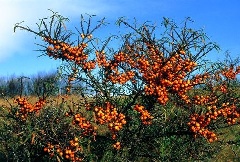home
H2160 - Dunes with Hippophaë rhamnoides
General
| Section |
|---|
| Column |
|---|
| General characteristics | |
|---|
Common name | Dunes with Hippophaë rhamnoides | Region | Europe | Water system | coastal waters | Nature parameter | Habitat types | HR nr | H2160 | Fact sheet by | K.E. van de Wolfshaar |
|
| Column |
|---|
|  | Picture: B. van Gennip |
|
|
Description habitat
General occurrence
In habitat type 2160, we can find scrub vegetation in which sea-buckthorn is abundant (Hippophae rhamnoides). If the scrub vegetation is well developed, various other shrubs will occur, such as Wild privet (Ligustrum vulgare), Common hawthorn (Crataegus monogyna), Black elderberry (Sambucus nigra), European barberry (Berberis vulgaris), European spindle (Euonymus europaeus), Common buckthorn (Rhamnus cathartica), Eglantine rose (Rosa rubiginosa) and Dog rose (Rosa canina). It often occurs in combination with common dune plants. In an optimal habitat, a number of rare roses can be found, such as Rosa sherardii and Rosa elliptica. This scrub vegetation belongs to the association of Berberidion vulgaris. This type can both be found in dune valleys and dry dunes.
Environmental boundary conditions
This habitat type can be found in the entire dune area of The Netherlands. Plant species richness is highest in the calcareous dune districts South of Bergen. Here, the shrubs are taller and have a more diverse structure. Especially Meijendel, Voorne, Goeree and Schouwen are well known for their beautiful dune bushes. In duneland with a lime deficiency, this type is best developed in relatively calcareous parts, such as the southern dune area of Texel #1.
Control and growth opportunities
This habitat type is very sensitive to acidification #1.
Dose-effect relations
This habitat type itself is a landscape characteristic. Therefore, these dose-effect relations have been based on habitat factors of occurring plant communities.
Flowchart
| Wiki Markup |
|---|
{flowchart}graph[
rankdir=LR]
nodesep=0.5
"node0" [
label = "Soil type|Districts|Salinity|Soil acidity"
shape = "record"
];
"node3" [
label = "HAI general"
shape = "record"
];
"node0":f1-> "node3" [style=italic,label="minimum"]
[
id = 2
];
{flowchart} |
Dose-effect relations
| Section |
|---|
| Column |
|---|
| | Chart |
|---|
| dataDisplay | true |
|---|
| legend | false |
|---|
| xlabel | soil type |
|---|
| dataOrientation | vertical |
|---|
| title | Soil type |
|---|
| type | bar |
|---|
| yLabel | HSI |
|---|
| |
Reference: #1 |
| Column |
|---|
| district | HSI |
|---|
Dune | 1 | Maritime | 1 | other | 0 |
Reference: #3 |
|
| Section |
|---|
| Column |
|---|
| Salinity | HSI |
|---|
very fresh | 1 | other | 0 |
Reference: #1 |
| Column |
|---|
| pH soil | HSI |
|---|
weak acidic | 1 | neutral | 1 | basic | 1 | other | 0 |
Reference: #1 |
|
Uncertainty and validation
 These dose-effect relations have not been validated.
These dose-effect relations have not been validated.
Applicability
These dose-effect relations have been based on habitat factors of occurring plant communities included in this habitat type. As this habitat type itself is a landscape characteristic, it is difficult to define relations.
Example project
At present, there is no example of a project available.
References
1
http://www.minlnv.nl/natura20002
Weeda, E.J., J.H.J. Schaminee, L. van Duuren (2003). Atlas van Plantengemeenschappen in Nederland. Deel3 Kust en binnenlandse pioniermilieus. KNNV Uitgeverij.
3
Van der Meijde, R. Heukels' Flora van Nederland. Wolters-Noordhof. 1996
These dose-effect relations have not been validated.
